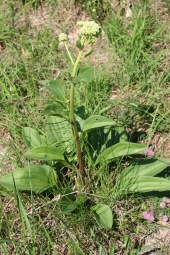

 5
5




A good fibre is obtained from the leaves[4], it is said to be suitable for textiles[115].

How Permies works: https://permies.com/wiki/34193/permies-works-links-threads
My projects on Skye: The tree field, Growing and landracing, perennial polycultures, "Don't dream it - be it! "
 4
4




Zone 6, 45 inches precipitation, hard clay soil




 6
6




Nancy Reading wrote:A whisper on the forum on using narrow leaved plantain for fibre and I'm trying to find out more. Anyone heard of it, or how it is used and extracted?
PFAF saysA good fibre is obtained from the leaves[4], it is said to be suitable for textiles[115].
[4] Grieve. A Modern Herbal (ooh, I've got that one - I'll look up what she says)
[115] Johnson. C. P. The Useful Plants of Great Britain (hmm, that could be one to look out for!)
--
"Whitewashed Hope: A Message from 10+ Indigenous Leaders and Organizations"
https://www.culturalsurvival.org/news/whitewashed-hope-message-10-indigenous-leaders-and-organizations












 5
5




The leaves contain a good fibre, which, it has been suggested, might be adapted to some manufacturing purpose.
How Permies works: https://permies.com/wiki/34193/permies-works-links-threads
My projects on Skye: The tree field, Growing and landracing, perennial polycultures, "Don't dream it - be it! "
 6
6




I'm only 65! That's not to old to learn to be a permie, right?












 4
4




How Permies works: https://permies.com/wiki/34193/permies-works-links-threads
My projects on Skye: The tree field, Growing and landracing, perennial polycultures, "Don't dream it - be it! "
 9
9




Zone 6, 45 inches precipitation, hard clay soil




 1
1




Nancy Reading wrote:Well that sounds promising Ac. The link you gave doesn't go to the quote you give however.
Unfortunately Mrs Grieve doesn't say much more that the quote from pfaf:
The leaves contain a good fibre, which, it has been suggested, might be adapted to some manufacturing purpose.
So not necessarily textile suggested there. I may have a bit of time to play tomorrow and see what scraping the leaves may involve..
--
"Whitewashed Hope: A Message from 10+ Indigenous Leaders and Organizations"
https://www.culturalsurvival.org/news/whitewashed-hope-message-10-indigenous-leaders-and-organizations
 6
6





Zone 6, 45 inches precipitation, hard clay soil




 9
9






Zone 6, 45 inches precipitation, hard clay soil




 2
2




'What we do now echoes in eternity.' Marcus Aurelius
How Permies Works Dr. Redhawk's Epic Soil Series
 2
2




Still slingin’ Avacado pits
 3
3




Joylynn Hardesty wrote:Is the fiber from just the seed stalks? Or are you using the veins of the leaves also?
Zone 6, 45 inches precipitation, hard clay soil
















 2
2




Suzie Grieve wrote: picked the stems then left them for a day then scraped the green off until just the fibres where left
How Permies works: https://permies.com/wiki/34193/permies-works-links-threads
My projects on Skye: The tree field, Growing and landracing, perennial polycultures, "Don't dream it - be it! "
 6
6




Zone 6, 45 inches precipitation, hard clay soil










 2
2




I'm only 65! That's not to old to learn to be a permie, right?
 7
7




Zone 6, 45 inches precipitation, hard clay soil





|
Don't sweat petty things, or pet sweaty things. But cuddle this tiny ad:
The new permaculture playing cards kickstarter is now live!
https://www.kickstarter.com/projects/paulwheaton/garden-cards
|




